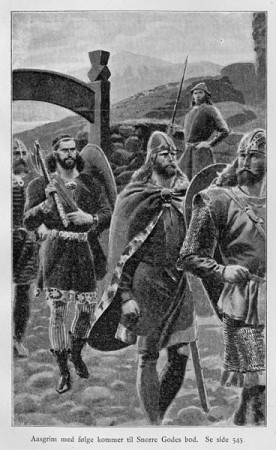Can Statistics show if the Icelandic Sagas were true?
– JANUARY 7, 2014
 The Icelandic sagas of the Norse people are thousand-year-old chronicles of brave deeds and timeless romances, but how true to Viking life were they? Writing in Significance, Pádraig Mac Carron and Ralph Kenna use a statistical network of associations between characters to find out.
The Icelandic sagas of the Norse people are thousand-year-old chronicles of brave deeds and timeless romances, but how true to Viking life were they? Writing in Significance, Pádraig Mac Carron and Ralph Kenna use a statistical network of associations between characters to find out.
While the stories involve a cast of thousands, recurring characters have emerged as the stories passed into historical legend. A set of recurring characters living within the same fictional world is not restricted to ancient stories, such as the Norse or Greek myths, but remains a popular device in modern comic and film franchises.
By exploring the number of ‘too-good-to-be-true’ interactions between protagonists, the researchers built a network of recurring characters which in turn could help reveal if the stories are invented or if they are based on a real society.
“We gathered data for 18 narratives, five of which contain over 100 characters each. These are Njáls saga, Laxdæla saga, Vatnsdæla saga, Egils saga Skallagrímssonar and Gísla saga Súrssonar,” said Pádraig Mac Carron. “We examined these five individually in order to compare different sagas to each other. We also studied the sagas collectively and from a network of 1547 individual characters we were able to gain insight into the structure of the overall saga society.”
In the article, the authors write:
We found that some of the family sagas are assortative and only the outlaw saga is strongly disassortative – Gisla the outlaw interacts with many minor characters. This reflects the fact that the story is centred on a single protagonist’s exploits instead of on a larger society. Egils saga has assortativity close to 0, in particular when we just consider the friendly network. This is a saga about a poet set in two different time periods, initially with his family in Norway and later in Iceland where it follows Egil’s life. The corresponding network, does not have a single cohesive social structure, which may account for its disassortativity. We see that, although the five sagas have many common features, the statistical analysis is capable of picking up differences in detail between them.
Among some of their findings is that the social networks that overlap Njáls saga and Laxdæla saga are so strong that it suggests that one of the sagas was a source for the other. Meanwhile, the strong amount of female-to-female interaction in Laxdæla saga suggests that it might have been written by a woman author. When taking a look at all 18 sagas and the 1547 characters in them, the statisticians found them to be “remarkably close to the six degrees of separation of modern society.”
 “We can conclude that whether the sagas are historically accurate or not, the properties of the social worlds they record are similar to those of real social networks,” said Ralph Kenna. “Although one cannot conclusively determine whether the saga societies are real, on the basis of network theory we can conclude that they are remarkably realistic.”
“We can conclude that whether the sagas are historically accurate or not, the properties of the social worlds they record are similar to those of real social networks,” said Ralph Kenna. “Although one cannot conclusively determine whether the saga societies are real, on the basis of network theory we can conclude that they are remarkably realistic.”
The article, ”Viking sagas: Six degrees of Icelandic separation Social networks from the Viking era”, appears in the December 2013 issue of Significance.




0 Comentarios